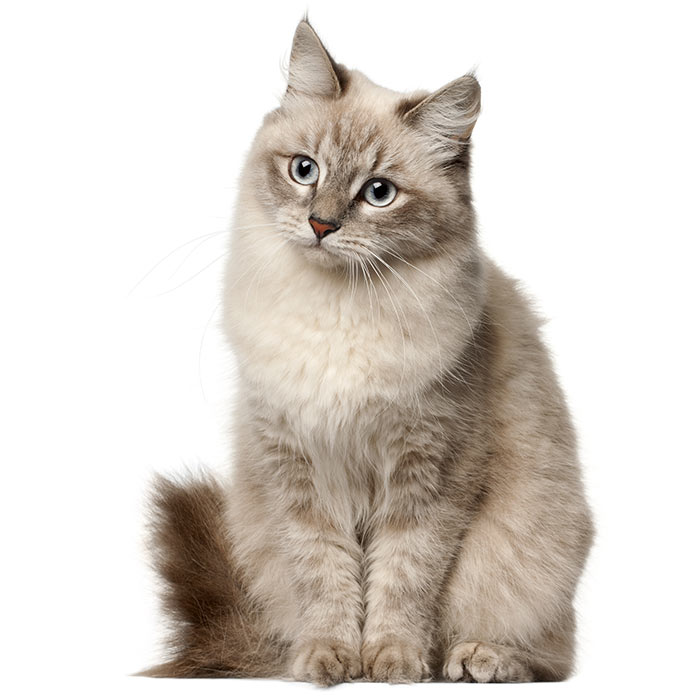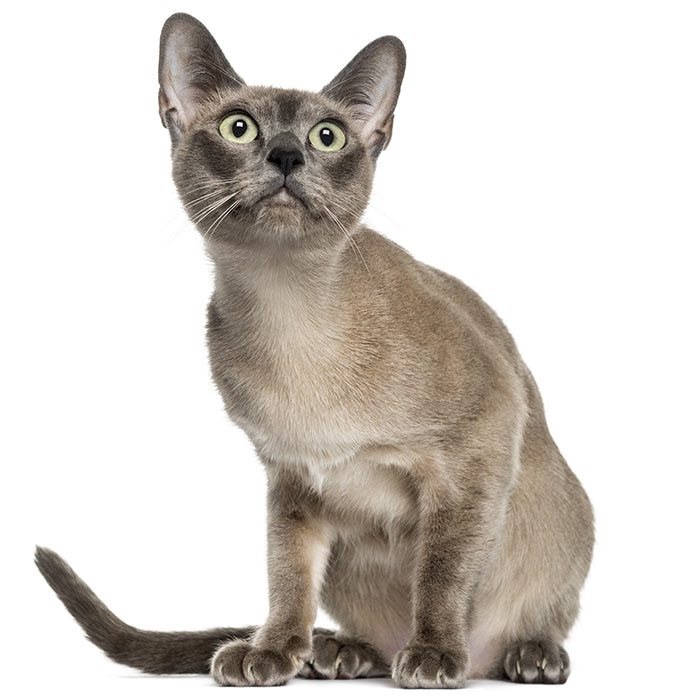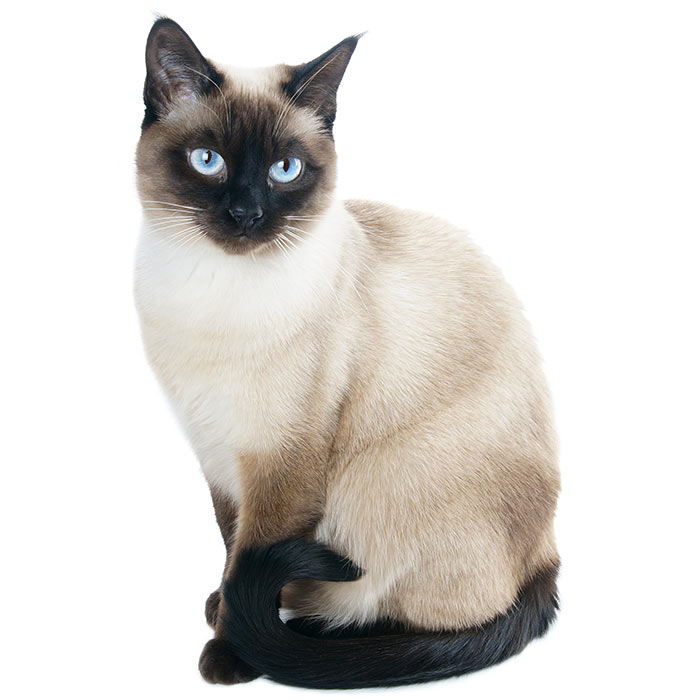Burmese


| Recommended for | Families, seniors or singles looking for an affectionate and sociable companion; excellent for active households or families with children and other pets |
| Breed Classification | Shorthair |
| Other names | European Burmese, American Burmese |
| Lifespan | 14 to 18 years |
| Size | Medium |
| Temperament | Affectionate, playful, outgoing |
| Intelligence | Highly intelligent and trainable; they quickly learn tricks and enjoy interactive games |
| Tendency to vocalise | Highly vocal, often using a soft, raspy voice to communicate with their humans frequently and expressively |
| Maintenance Level | Low grooming requirements, high daily play and social interaction requirements |
| Health Risk | The Burmese cat is generally healthy but can be prone to genetic conditions such as hypokalemia, craniofacial defects, diabetes (especially in European lines), and dental or neurological issues. |
Insuring a Burmese?
Get our award-winning Nose-to-Tail Cover with up to $30k annual benefit limit, up to 90% of eligible vet bills back, and no sub-limits.
Get a quick quote
Is this breed right for you?
Try our breed selector quiz to find out your best matching breed!
Insuring a Burmese?
Get our award-winning Nose-to-Tail Cover with up to $30k annual benefit limit, up to 90% of eligible vet bills back, and no sub-limits.
Get a quick quote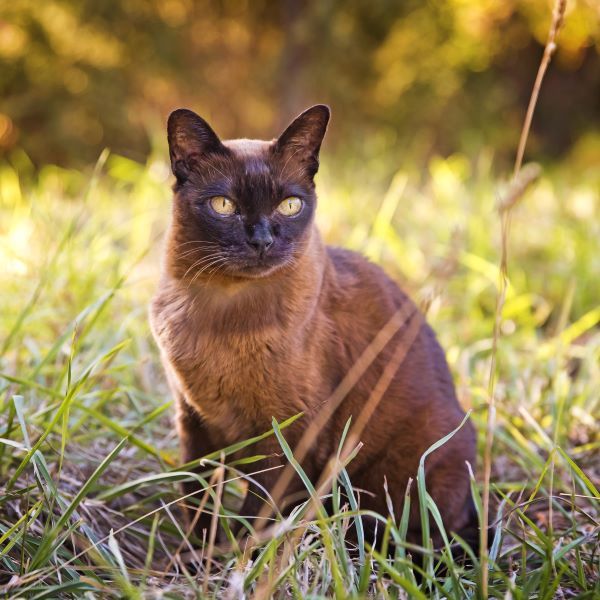
Breed history of Burmeses
The Burmese Cat originated in Burma (known today as Myanmar), though its exact origins are not precisely known. There is a mention of a copper-coloured Burmese-like cat in the ancient Thai Cat Book, written between 1350 and 1767.
However, the breed as we know it today was developed primarily in the United States and the United Kingdom. The modern Burmese was founded in 1939 by Dr Joseph Thompson, who imported a small, brown, female cat to San Francisco. This cat, named Wong Mau, was bred with a Seal Point Siamese and their offspring became the ancestors of today’s breed.
The breed was also developed in the UK in the late 19th century but eventually died out, before experiencing a revival in the 1950s.
Burmese cats were introduced to Australia in 1957 when a cat called Tomahawk was imported from the UK. The Burmese Cat Society of Australasia was founded in New South Wales in 1967.
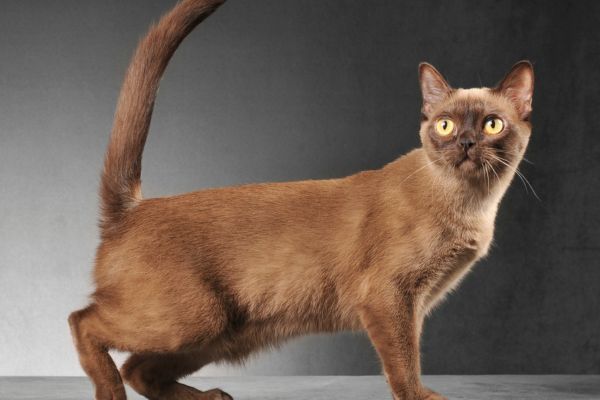
Physical description of Burmeses
The Burmese is a medium-sized cat with a muscular, compact build. Despite their relative heaviness, they are elegant and graceful cats with strong muscles and good bone structure. They have large, expressive, wide-set eyes in striking shades of golden-yellow, their ears are medium-sized with rounded tips, and their tail is medium-length, straight, and gracefully tapers.
One of the Burmese cat’s most distinctive features is its short, sleek, glossy coat. Their coat is short, fine, and satin-like, appearing in a variety of colours, including sable, champagne, platinum and blue.
| Weight range | Males: 4.5 to 6.5 kg; females: 3.5 to 5.5 kg |
| Height range | 20 t0 25 cm at the shoulder |
| Colours | Solid colours such as sable, champagne, blue, and platinum |
| Coat length | Short |

Burmese personality and temperament
Burmese cats are affectionate, playful, and outgoing. They form close bonds with their families, seeking regular interaction without being overly demanding. They are very playful cats and love being around their family and being stroked. Almost like dogs, Burmese want to be involved in every aspect of their owners’ lives – they’ll follow you around while you do chores, cook meals and watch television. They have been known to even win over “dog people” because of their tendency to shower guests with attention and affection.
The Burmese is a highly adaptable breed that thrives in indoor environments. They enjoy spending time close to their human companions and are content living inside, where they can engage in play and daily interaction. While not known for roaming far, they do enjoy exploring their surroundings and benefit from a safe, enclosed outdoor space or supervised time outside.
Very well-suited to apartment living, they don’t need large areas to stay happy and are comfortable in smaller spaces with access to toys, scratching posts, and climbing spots. Regular play sessions and companionship help keep them active and content indoors. While they enjoy companionship, Burmese are confident and independent enough to entertain themselves comfortably.

Burmeses with kids and other pets
Burmese are typically great with children and other pets, particularly if raised together from a young age. Their friendly, adaptable nature makes them excellent companions for families while their patient, gentle disposition suits homes with kids and other animals, including dogs.
Burmese get along well with children and other pets and make particular friends with children if they are gently treated. They don’t do well when left alone for a long time, unless they have another pet to keep them company.
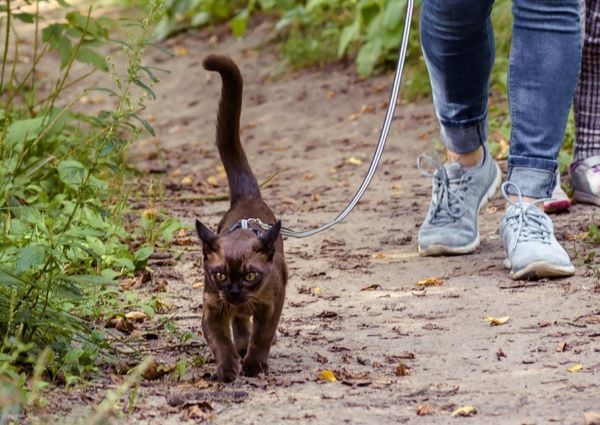
Burmese training and exercise
Burmese cats have moderate energy levels, enjoying active play without being overly energetic. They thrive on daily interaction and mental stimulation but are equally happy relaxing and cuddling with family members. Regular play sessions and companionship keep them content and satisfied.
Burmese are active and playful, so they benefit from daily exercise to stay mentally and physically stimulated. They enjoy games like fetch, puzzle toys, and interactive play with feather wands or balls. Providing climbing structures, scratching posts, or cat trees can help them burn off energy and satisfy their curiosity. They can also learn how to retrieve and to walk on a leash.
| Energy level | |
| Exercise requirements |

Burmese feeding and nutrition
The Burmese thrives on a balanced diet suited to its playful and energetic temperament. High-quality, protein-rich food is essential to support muscle tone and overall health. A combination of wet and dry cat food is ideal to maintain hydration and ensure optimal digestive function. Choose food enriched with essential vitamins, minerals, and fatty acids to keep their coat glossy and their body healthy.
Portion control is important as Burmese cats are known for their hearty appetites and may gain weight if overfed. Their meals should be split into two or three daily servings to manage weight effectively. Always ensure fresh water is available and consult your vet for tailored dietary advice based on your Burmese cat’s age, health, and activity level.

Burmese care and grooming
The Burmese has a short, sleek coat that is easy to maintain and requires minimal grooming. Brushing once a week is usually enough to remove loose hairs and keep the coat glossy. While bathing is rarely necessary, an occasional bath can help maintain coat health. Routine care should also include regular ear cleaning, nail trimming, and dental hygiene, such as tooth brushing or dental treats, to support overall wellbeing.
Burmese cats cope well in mild climates but should be kept indoors during extreme weather. Their short coat provides limited protection from cold temperatures, so additional warmth may be needed in winter. They generally handle warmer conditions well, provided they have access to shade, water, and a cool indoor environment.
Health issues for Burmeses
- Diabetes Mellitus is a known concern in Burmese cats, particularly in older or overweight individuals. It affects their ability to regulate blood sugar and may require dietary management or insulin treatment. Symptoms include increased thirst, frequent urination, and weight loss. Early diagnosis through regular vet check-ups is essential.
- Hypokalaemia is a genetic condition seen in some Burmese lines, leading to low potassium levels in the blood. This can cause muscle weakness, especially in the neck. Affected cats may need lifelong supplementation, so genetic screening and regular blood tests are important.
- Craniofacial Defect is a rare but serious inherited disorder found in some Burmese lines, typically identified in kittens. Ethical breeding programs aim to reduce the risk of this condition, so choosing a responsible breeder is vital.
- Dental Disease, including gingivitis and periodontal issues, is also common in Burmese cats. Regular brushing and professional dental care help prevent oral health problems and support long-term wellbeing.
Not all conditions are covered by Pet Insurance. For details of Bow Wow Meow Pet Insurance cover, refer to the Product Disclosure Statement.
What do Burmese owners claim for the most?
- Renal (kidney) Disorder
- Constipation
- Faecal Appearance - Abnormal
- Vomiting
- Wound
Thinking about insuring a Burmese
Thinking about insuring a Burmese
Learn moreThinking about insuring a Burmese
Learn moreFree engraved pet ID tag on sign up3
Customer Satisfaction
21 day cooling off
Easy to use Pet Portal

GapOnly® in vet claims
MORE INFORMATION
Burmese Cat Society of Australasia Inc: http://www.burmese.asn.au/
The Burmese Cat Club: https://burmesecatclub.com/
Burmese Cat Association: https://www.burmesecatassociation.org/


